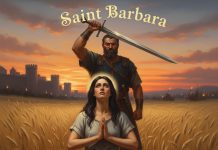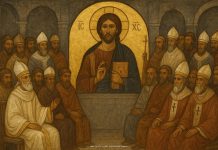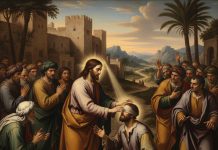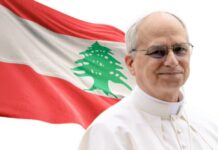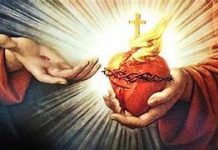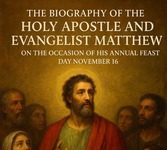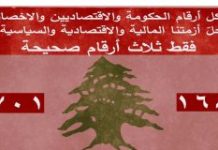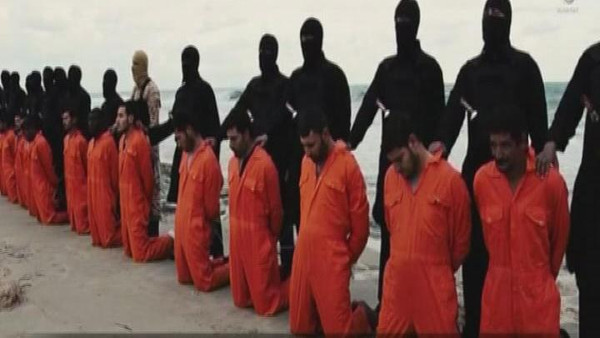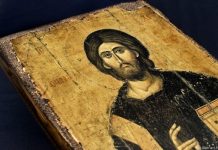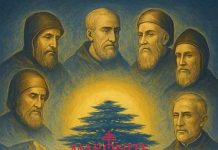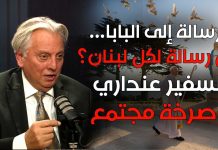مقالة مهمة للغاية تبين عمق إيمان الأقباط ال 21 الذين قطعت رؤوسهم داعش في ليبيا سنة 2015.. رفضوا التخلي عن إيمانهم واختاروا السيف ككل شهداء الكنيسة
مريم وهبة/موقع فيسيغراد 24/18 شباط/2025
A very important article that shows the depth of faith of the 21 Copts who were beheaded by ISIS in Libya in 2015. They refused to abandon their faith and chose the sword like all the martyrs of the church.
The Problem with Christian Martyrs
Mariam Wahba/Visegrad24/February 18/2025
Ten years ago, 21 Coptic Christians were given a choice by ISIS: renounce their faith or die. They chose the sword. Their sacrifice wasn’t passive – it was a powerful testimony to unwavering faith.
In a modern-day Golgotha, on a desolate beach in Libya ten years ago, twenty-one men in orange jumpsuits were marched to their deaths by black-clad executioners. The world watched as ISIS broadcast their final moments against the endless Mediterranean. A militant declared in flawless American English, “People of the cross, followers of the hostile Egyptian Church.” Those words made it clear that their crime was their faith, and their sentence was death.
Each man had been given an ultimatum; renounce Christianity or die at the sword. They all chose the sword.
Their final words, as shown in the video before their brutal decapitation, were not cries for mercy but a prayer: “Ya Rab Yasua,” or “O Lord Jesus.” These words echoed pointedly in Egypt. In the West, however, few seemed to understand the remarkable expression of faith they had witnessed.
Ordinary Men, Extraordinary Faith
These men were not soldiers. They carried no weapons and waged no wars. They were construction workers and laborers who had been kidnapped by the brutal Islamist group. They were young men with dreams for a better life. Among them was Samuel Stephanos Kamel, a 23-year-old electrician from el-Aour, a small village in the city of Minya, Egypt.
Samuel had left home two years prior in search of work to provide for his family. Specifically, he wanted to help his brother raise money for a wedding. The older brother, Beshoy, knelt beside him on that shore. Samuel was known for his sense of humor, his ability to bring levity to any situation, and his service as a deacon in his local church. He also volunteered with “Brothers of Christ,” a program that anonymously delivered food and clothing to the needy.
“My uncle taught me that kindness does not need to be loud to make a difference,” his nephew told me.
Three days before the world saw the video, their families received photographs of the men in orange jumpsuits. At first, the images sparked hope that their loved ones were still alive. But they also signaled that the worst was yet to come. There were no demands and no negotiations. Just an ultimatum that had already been answered. On that beach, there were no dreams left to hold, only the certainty of death and the quiet courage of men who knew to whom they belonged.
Their God Is My God: The Choice That Cost a Life
Another man that stood apart was Matthew Ayariga, about whom little is known. He was not born into the Coptic men’s country or their faith, yet when the moment of decision arrived, he made it his own. According to an ISIS militant who was later captured, Matthew was given a final chance to save himself. He could renounce Christianity and walk away. Instead, he looked at the men beside him and said, “Their God is my God.” With those words, he knelt alongside them, embracing martyrdom as his own.
Western Denial of True Martyrdom
Three days after the world saw the video, a traditional Coptic prayer service was held in el-Aour. Grief gave way to something surprising: joy, even pride. The families spoke not just of loss, but of victory that their sons had chosen faith over life.
When their bodies were found and returned to Egypt, they were canonized as saints. Their icons adorn many church walls, and their courage is told in children’s storybooks.
Yet when the infamous video made its way onto the nightly segments of American and other western news shows, the world did not weep. While some American Christian news outlets displayed clarity, journalists and elected leaders resorted to vague or diluted language that avoided addressing the true reason for their deaths. News outlets danced around the truth of why they were killed. The White House referred to them merely as “Egyptian citizens.” There was a cold, clinical unease in the way their murders were discussed—if they were discussed at all.
Why the West Refused to Mourn
This is the problem with Christian martyrs. Not their existence, but rather the discomfort their fate reveals. A martyr does not allow us to remain neutral. He reminds us that faith is not just an intellectual exercise but a question of life and death.
For many in the West, where faith is often seen as a cultural artifact rather than a force that shapes lives and fates, this is deeply unsettling. It is easier, then, to dismiss their sacrifice, frame their deaths as an isolated act of terrorism by refusing to acknowledge the reason they were killed, and see them as tragic victims of the wrong place and the wrong time. This misses the true nature of their testimony.
A martyr, like Samuel and his brother, forces the West to reckon with the ultimate question: how much does our faith define us? These men, in the face of a gruesome death, stood firm. They demonstrated that even when the alternative was the sword, faith was the conviction that shaped who they were.
Samuel’s family does not speak of revenge. They speak of faith. They speak of how his sacrifice has strengthened their own faith. The church and the families do not mourn as those who have no hope. They see these men not as victims but as victors.
Saints in Orange
In the final frame of the ISIS video, the men’s blood darkens the ocean waves. To ISIS, this scene was a declaration of conquest and a symbol of their domination. To the Copts, it was something else entirely: a baptism, a sacrifice of conviction, and an eternal symbol of courage sealed in water.
These twenty-one men are not just another tragic footnote in the long and bloody history of Middle Eastern Christianity. Their sacrifice is not a passive loss but an active testimony to their unwavering faith. In a world that resists acknowledging their sacrifices as a defense of their faith, the story of these men remains a pointed challenge to our understanding of and commitment to faith.
*Mariam Wahba is a research analyst at FDD focused on Egypt and minorities in the Middle East.
https://www.fdd.org/analysis/op_eds/2025/02/14/the-problem-with-christian-martyrs/
مقالة مهمة للغاية تبين عمق إيمان الأقباط ال 21 الذين قطعت رؤوسهم داعش في ليبيا.. رفضوا التخلي عن إيمانهم واخاروا السيف ككل شهداء الكنيسة
المشكلة مع الشهداء المسيحيين
مريم وهبة/موقع فيسيغراد 24/18 شباط/2025
(ترجمة موقع المنسقية بحرية تامة)
قبل عشر سنوات، أعطت داعش 21 مسيحيًا قبطيًا خيارًا: التخلي عن إيمانهم أو الموت. اختاروا السيف. لم تكن تضحياتهم سلبية – بل كانت شهادة قوية على الإيمان الراسخ. في الجلجثة الحديثة، على شاطئ مهجور في ليبيا قبل عشر سنوات، تم اقتياد واحد وعشرين رجلاً يرتدون بدلات برتقالية إلى حتفهم من قبل جلادين يرتدون ملابس سوداء. شاهد العالم داعش تبث لحظاتهم الأخيرة ضد البحر الأبيض المتوسط الذي لا نهاية له. أعلن أحد المتشددين باللغة الإنجليزية الأمريكية الخالية من العيوب: “شعب الصليب، أتباع الكنيسة المصرية المعادية”. أوضحت هذه الكلمات أن جريمتهم كانت إيمانهم، وعقوبتهم هي الموت. لقد أُعطي لكل رجل إنذارٌ نهائي؛ التخلي عن المسيحية أو الموت بالسيف. اختاروا جميعًا السيف. لم تكن كلماتهم الأخيرة، كما ظهر في الفيديو قبل قطع رؤوسهم الوحشي، صرخات طلباً للرحمة، بل صلاة: “يا رب يسوع”. تردد صدى هذه الكلمات بشكل واضح في مصر. ولكن في الغرب، بدا أن قِلة من الناس يفهمون التعبير الرائع عن الإيمان الذي شهدوه.
رجال عاديون، إيمان خارق
لم يكن هؤلاء الرجال جنودًا. لم يحملوا أسلحة ولم يشنوا حروبًا. كانوا عمال بناء وعمالاً اختطفتهم الجماعة الإسلامية الوحشية. كانوا شبابًا يحلمون بحياة أفضل. ومن بينهم صموئيل ستيفانوس كامل، كهربائي يبلغ من العمر 23 عامًا من العور، وهي قرية صغيرة في مدينة المنيا بمصر. كان صموئيل قد غادر منزله قبل عامين بحثًا عن عمل لإعالة أسرته. وعلى وجه التحديد، أراد مساعدة شقيقه في جمع المال لحفل زفاف. ركع الأخ الأكبر، بيشوي، بجانبه على ذلك الشاطئ. كان صموئيل معروفًا بروح الدعابة التي يتمتع بها، وقدرته على إضفاء البهجة والسرور على أي موقف، وخدمته كشمّاس في كنيسته المحلية. كما تطوع مع “إخوة المسيح”، وهو برنامج يسلم الطعام والملابس للمحتاجين دون الكشف عن هويتهم.
“علمني عمي أن اللطف لا يحتاج إلى أن يكون صاخبًا لإحداث فرق”، هكذا أخبرني ابن أخيه.
قبل ثلاثة أيام من مشاهدة العالم للفيديو، تلقت أسرهم صورًا للرجال بالبدلات البرتقالية. في البداية، أشعلت الصور الأمل في أن أحباءهم ما زالوا على قيد الحياة. لكنها أشارت أيضًا إلى أن الأسوأ لم يأت بعد. لم تكن هناك مطالب ولا مفاوضات. مجرد إنذار نهائي تم الرد عليه بالفعل. على ذلك الشاطئ، لم يتبقَّ أي أحلام، فقط يقين الموت والشجاعة الهادئة للرجال الذين عرفوا لمن ينتمون.
إلههم هو إلهي: الاختيار الذي كلف حياة
كان هناك رجل آخر تميز عن غيره وهو ماثيو أياريجا، الذي لا يُعرف عنه الكثير. لم يولد في بلد الرجال الأقباط أو دينهم، ولكن عندما جاءت لحظة القرار، اتخذها لنفسه. وفقًا لمقاتل داعش الذي تم القبض عليه لاحقًا، مُنح ماثيو فرصة أخيرة لإنقاذ نفسه. كان يمكنه التخلي عن المسيحية والرحيل. ولكن بدلاً من ذلك، نظر إلى الرجال بجانبه وقال: “إلههم هو إلهي”. وبهذه الكلمات، ركع بجانبهم، واحتضن الاستشهاد باعتباره استشهاده.
الإنكار الغربي للاستشهاد الحقيقي
بعد ثلاثة أيام من مشاهدة العالم للفيديو، أقيمت صلاة قبطية تقليدية في العور. أفسح الحزن المجال لشيء مدهش: الفرح، وحتى الفخر. لم تتحدث الأسر عن الخسارة فحسب، بل تحدثت أيضًا عن النصر الذي اختاره أبناؤهم للإيمان على الحياة. وعندما تم العثور على جثثهم وإعادتها إلى مصر، تم تقديسهم كقديسين. وتزين أيقوناتهم جدران العديد من الكنائس، ويتم سرد شجاعتهم في كتب قصص الأطفال. ومع ذلك، عندما شق الفيديو سيئ السمعة طريقه إلى المقاطع المسائية من البرامج الإخبارية الأمريكية وغيرها من البرامج الغربية، لم يبكِ العالم. وفي حين أظهرت بعض وسائل الإعلام المسيحية الأمريكية وضوحًا في الطرح، لجأ الصحفيون والقادة المنتخبون إلى لغة غامضة أو مخففة تجنبت معالجة السبب الحقيقي لوفاتهم. لقد أشار البيت الأبيض إليهم باعتبارهم “مواطنين مصريين” فحسب. وكان هناك شعور بارد بالانزعاج السريري في الطريقة التي تمت بها مناقشة جرائم القتل التي ارتُكبت بحقهم – إذا ما تمت مناقشتها على الإطلاق.
لماذا رفض الغرب الحداد
هذه هي المشكلة مع الشهداء المسيحيين. ليست وجودهم، بل الانزعاج الذي يكشفه مصيرهم. فالشهيد لا يسمح لنا بالبقاء على الحياد. فهو يذكرنا بأن الإيمان ليس مجرد تمرين فكري بل مسألة حياة أو موت. بالنسبة للعديد من الناس في الغرب، حيث يُنظَر إلى الإيمان غالبًا باعتباره قطعة أثرية ثقافية وليس قوة تشكل الحياة والمصائر، فإن هذا أمر مزعج للغاية. ومن الأسهل إذن أن نرفض تضحياتهم، ونؤطر موتهم باعتباره عملاً إرهابيًا معزولاً، برفض الاعتراف بالسبب الذي دفعهم إلى القتل، وننظر إليهم باعتبارهم ضحايا مأساويين في المكان الخطأ والوقت الخطأ. وهذا يتجاهل الطبيعة الحقيقية لشهادتهم.
إن الشهيد، مثل صموئيل وشقيقه، يجبر الغرب على التعامل مع السؤال النهائي: إلى أي مدى يحدد إيماننا هويتنا؟ لقد وقف هؤلاء الرجال بثبات في مواجهة موت مروع. لقد أثبتوا أنه حتى عندما كان البديل هو السيف، فإن الإيمان هو القناعة التي شكلت شخصياتهم. لا تتحدث عائلة صموئيل عن الانتقام. بل تتحدث عن الإيمان. وتتحدث عن كيف عززت تضحيته إيمانها. ولا تنوح الكنيسة والعائلات على هؤلاء الرجال باعتبارهم بلا أمل. بل إنهم لا يرون هؤلاء الرجال كضحايا بل كمنتصرين.
القديسون باللون البرتقالي
في الإطار الأخير من فيديو داعش، تغمق دماء الرجال أمواج المحيط. بالنسبة لداعش، كان هذا المشهد إعلانًا للغزو ورمزًا لسيطرتهم. أما بالنسبة للأقباط، فكان شيئًا مختلفًا تمامًا: معمودية، وتضحية بالإيمان، ورمز أبدي للشجاعة مختوم في الماء. إن هؤلاء الرجال الواحد والعشرين ليسوا مجرد حاشية مأساوية أخرى في التاريخ الطويل والدموي للمسيحية في الشرق الأوسط. إن تضحيتهم ليست خسارة سلبية بل شهادة نشطة على إيمانهم الراسخ. وفي عالم يقاوم الاعتراف بتضحياتهم كدفاع عن إيمانهم، تظل قصة هؤلاء الرجال تحديًا واضحًا لفهمنا للإيمان والتزامنا به.
*مريم وهبة هي محللة أبحاث في مؤسسة الدفاع عن الديمقراطية، تركز على مصر والأقليات في الشرق الأوسط.
https://www.fdd.org/analysis/op_eds/2025/02/14/the-problem-with-christian-martyrs/




